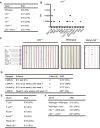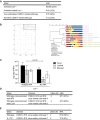Commensal microbiota influence systemic autoimmune responses
- PMID: 25599993
- PMCID: PMC4331001
- DOI: 10.15252/embj.201489966
Commensal microbiota influence systemic autoimmune responses
Abstract
Antinuclear antibodies are a hallmark feature of generalized autoimmune diseases, including systemic lupus erythematosus and systemic sclerosis. However, the processes underlying the loss of tolerance against nuclear self-constituents remain largely unresolved. Using mice deficient in lymphotoxin and Hox11, we report that approximately 25% of mice lacking secondary lymphoid organs spontaneously develop specific antinuclear antibodies. Interestingly, we find this phenotype is not caused by a defect in central tolerance. Rather, cell-specific deletion and in vivo lymphotoxin blockade link these systemic autoimmune responses to the formation of gut-associated lymphoid tissue in the neonatal period of life. We further demonstrate antinuclear antibody production is influenced by the presence of commensal gut flora, in particular increased colonization with segmented filamentous bacteria, and IL-17 receptor signaling. Together, these data indicate that neonatal colonization of gut microbiota influences generalized autoimmunity in adult life.
Keywords: antinuclear antibodies; commensal microbiota; systemic autoimmunity.
© 2015 The Authors.
Figures

3-month-old wild-type (C57BL/6), Ltbr−/−, Lta−/−, LIGHT−/−, and Ltbr−/−Hox11−/− mice; percentage of mice with at least one ANA.
6-month-old Ltbr−/− mice (n = 15); titers of individual mice.
LIA of 6-month-old Ltbr−/− mice, wild-type mice, and 3-month-old Rorγt-Ltb−/− mice.
LTβR-Fc or control immunoglobulin (Ig)-treated wild-type mice; percentage of mice with at least one ANA. E denotes gestational day. *ANA were determined with LIA at the age of 3 months. **ANA were determined with LIA 3 months after the start of treatment.
3-month-old cell-specific LT knockout mice; percentage of mice with at least one ANA.
Bone marrow cells from wild-type or Ltbr−/− mice were transferred at neonatal age into lethally irradiated wild-type or Ltbr−/− mice; percentage of mice with at least one ANA. ANA were determined with LIA at the age of 3 months.

Thymic reconstitution was analyzed by counting total cell number and flow cytometry for cell percentages. Numbers represent the percentages within the indicated regions (left panel). No significant differences were found. Data represent means ± s.e.m.
T-cell reconstitution of spleen was assessed by flow cytometry. Numbers represent the percentages within the indicated regions.
Total IgG from nude mice engrafted with Ltbr−/− or wild-type thymi was determined by ELISA. No significant differences were found. Data represent means ± s.e.m.
Sera were collected 3 months after transplantation and tested for ANA; percentage of mice with at least one ANA reactivity.

Ltbr−/− mice were treated or not with antibiotics from birth (upper panel), conventionalized or germfree wild-type mice were treated with the LTβR-Fc fusion protein from gestational day 18 until 6 weeks after birth (lower panel); percentage of mice with at least one ANA. ANA were tested with LIA at the age of 3 months.
16S rRNA gene analysis of luminal samples of wild-type, ANA-positive, and ANA-negative Ltbr−/− mice. Left panel: Beta diversity plot using multidimensional scaling on Bray–Curtis dissimilarities distances. Right panel: Hierarchical cluster analysis using Pearson's correlation. Bacteria community compositions differ in the different groups. Please note that Candidatus arthromitus, according to Thompson et al (2012), should be renamed Candidatus savagella.
Real-time PCR for SFB in luminal, mucosal, and fecal samples of multiple ANA-positive and ANA-negative Ltbr−/− mice. Analysis with ANOVA,P = 0.02 for differences between groups, n = 4 mice per group. Data represent means ± s.e.m.
C3H/HeN germfree pregnant mice were treated with the LTβR-Fc fusion protein on day 16 and 18 of gestation to prevent the development of PP in their offspring. Pups were also treated in the neonatal period to prevent the development of ILF. Mice were colonized at 8 weeks of age with SFB or E. coli and were sacrificed on d20 or on d60 postcolonization; percentage of mice with at least one ANA. E denotes gestational day.
LTβR-Fc-treated wild-type or IL17R−/− mice; percentage of mice with at least one ANA. E denotes gestational day. ANA were determined with LIA at the age of 3 months
References
-
- Barton HA, Taylor NM, Lubbers BR, Pemberton AC. DNA extraction from low-biomass carbonate rock: an improved method with reduced contamination and the low-biomass contaminant database. J Microbiol Methods. 2006;66:21–31. - PubMed
-
- Bolotin A, de Wouters T, Schnupf P, Bouchier C, Loux V, Rhimi M, Jamet A, Dervyn R, Boudebbouze S, Blottiere HM, Sorokin A, Snel J, Cerf-Bensussan N, Gaboriau-Routhiau V, van de Guchte M, Maguin E. Genome sequence of “Candidatus Arthromitus” sp. strain SFB-mouse-NL, a commensal bacterium with a key role in postnatal maturation of gut immune functions. Genome Announc. 2014;2:e00705–e00714. - PMC - PubMed
Publication types
MeSH terms
Substances
LinkOut - more resources
Full Text Sources
Other Literature Sources
Molecular Biology Databases

